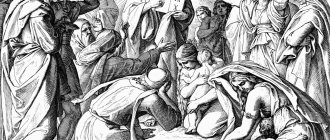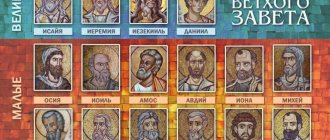The Bible and world religions
Some of the texts that make up the Bible are sacred not only to Christianity, but also to many other Abrahamic religions, such as Islam, Judaism, and lesser-known faiths such as Rastafarianism and Karaiteism. Adherents of these religions make up slightly more than half of the world's population.
Of course, each religion has its own Scripture and believes it differently, but the oldest stories of the Old Testament form the backbone of all Abrahamic religions.
Who wrote the Bible?
How did the Bible come to be? The Old Testament indicates the authorship of most of the books - the books of the prophets and judges are named after the names of their creators. The Pentateuch was attributed to Moses, with the exception of a few lines added later. But in the 18th century, scholars Jean Astruc and Johann Eichhorn suggested that the Tanakh (Hebrew Bible) was created by merging two sources. This idea was prompted by the repetition of certain events and the alternation of two different names of God - Yahweh and Elohim. Moreover, the last Name sounds in the plural.
Later, scientists came to the conclusion that the Bible is a “patchwork quilt” of many texts by different authors from different times, written in Hebrew and Aramaic. For example, the book of the prophet Ezekiel consists of three different texts. But this scientific evidence does not make the Bible any less valuable to people.
As for the New Testament, there are also many controversial issues there. Someone, for example, argues furiously about the original number of books in the New Testament. There is no unity on this issue in the scientific community. Which indicates the high importance of the text and the spiritual information that this text carries.
Influence of the Bible
It is worth noting separately that no other book has been able to achieve such popularity and have such an impact on the social development of mankind over generations and millennia as the Bible. In fact, most of the history of our era was determined by the Bible (Tanakh, Koran) and man's attitude towards it.
How to quickly and easily remove stains from jeans from upholstery: simple instructions
Watering with cold water and more: how to save trees from return frosts
Kirill Zaitsev spoke about perfectionism, bloody calluses and personal life
There is much debate about where the first biblical writings and various books came from, but what can science tell us about their age?
Who is the author of the Bible?
Estimated reading time: 6 minutes.
Anyone who attended literature classes at school remembers that reading any work of fiction begins with getting to know the era in which it was written, and, of course, getting to know the personality of the author. This is not accidental: who, if not the author, can tell us what exactly he wanted to express with the help of his work. Therefore, when starting serious and meaningful reading, it would not be a bad idea to become as closely acquainted as possible with the way of thinking of the person whose book we are holding in our hands. Trying to think like a writer, to look at the world through his eyes, is one of the ways that helps us extract the maximum meaning from a text. Only in this case, barely noticeable hints and allusions are revealed and become clear, which the author himself and his contemporary see perfectly well, but which are closed to a representative of a different cultural and historical environment.
Reading such an important book as the Bible is no exception to this school rule. In order to understand the meanings it contains, you need to look at its text through the eyes of the one who wrote it...
But who wrote the Bible?
To answer this question, it is necessary to turn to the meaning of the word “Bible” itself. The ancient Greeks carried on a brisk trade with a Phoenician city called B and Blos. One of the materials they bought here was Egyptian papyrus. Books were made from it. Over time, their production became so strongly associated among the Greeks with this city that all books in general began to be named after it. So, in ancient Greek, byblos is a book. “Bible” is the plural of “byblos.” Thus, the word “Bible” can be translated into Russian as “books”.
The plural is not accidental. The Bible is a collection that consists of 77 books. These books are divided into two large groups. The first is called the Old Testament . It includes 50 books , most of which are written in Hebrew . They describe the events of sacred history from the creation of the world to the Nativity of Jesus Christ.
Moses receiving the tablets. Monastery of St. Catherine, Sinai (mosaic)
The second part is called the New Testament and consists of 27 books . All of them are written in ancient Greek . They tell about the life and teaching of Jesus Christ, as well as the fate of his closest disciples, the apostles .
It turns out that the Bible was written, as we would say now, by a whole team of authors.
All of them were mainly of Jewish origin, but lived in different historical eras. For example, the core of the Old Testament, the Pentateuch, was written by the prophet Moses around the 15th century. BC. In his books, he outlined the religious, moral and legal norms that formed the basis of the Old Testament religion. The Old Testament books of the Bible continued to be written after Moses until the era of the conquests of Alexander the Great, that is, until the 3rd century. BC. Their authors were outstanding representatives of the Jewish people: its judges, kings, priests and prophets. These works differ from each other not only in content. Each has its own special genre and literary style. Here we can find stories, chronicles, poetry, parables, epics, legislative collections and even riddles.
The situation is similar with the New Testament. This is a team effort. Its authors are the disciples of Jesus Christ, the apostles. However, if the books of the Old Testament were written over more than a thousand years, the books of the New Testament were written over the course of only one, the first century A.D. Like the books of the Old Testament, the New Testament works differ from each other in their literary features. Here you can find books written in the genre of gospels (that is, good news), historical narratives, letters and prophetic sayings.
Apostle John the Theologian
Initially, the works of biblical authors were scattered and represented separate scrolls: one book - one scroll. However, at the dawn of the Christian era, it was decided to combine all these scrolls under one cover. This is how the collection we call the Bible appeared.
On what basis did these books, written at different times, by different people, different from each other in genre, language, literary style and content, become one collection? What do they have in common?
First of all, this is, of course, their main topic. They all tell us about God and how He works in this world. We are talking about His most vivid imprints, both in the lives of individuals and in the destinies of entire nations.
More specifically, the central nerve of the biblical narrative is the story of how God saves humanity, which, after the fall of Adam, found itself in the grip of sin and death. This grand plan is being implemented in two stages.
The first is described in the Old Testament. It talks about how God prepares people for the coming of the Messiah, that is, the Savior. The main character of the Old Testament story is Israel, God's chosen people. Deliverance must come through him. The second stage is described in the New Testament. This is the culmination of the biblical narrative: the Savior comes. The Lord Himself becomes a man and creates the Church, a new Israel, into which all people can enter. In parallel with this dramatic and large-scale canvas of salvation history, the Bible reveals important truths about the spiritual world, the material world, and their relationships.
However, it is not only the general theme of the narrative that gives unity to the biblical books. Its roots go much deeper. All biblical writers drew their inspiration from a common source. This source was the Spirit of God. In other words, if a brilliant poet is inspired by a muse, then those who wrote the Bible were inspired by God Himself. The Holy Spirit dwelt in the heart of each of them, which is why biblical authors are often called prophets. As befits prophets, they possessed supernatural gifts. The Lord revealed to them what was hidden from the eyes of other people, helped them to see this world and everything that happens in it through His eyes. The task of the prophet was to express this revelation using human concepts and words in suitable images and appropriate literary form.
At the same time, writing talent played a secondary role here. Not all prophets were outstanding writers.
Some of them did not even have a good education. However, they were all geniuses of spiritual life through whom God Himself spoke. It is this divine fire that is felt on the pages of even biblical books that are not entirely perfect from an artistic point of view.
For this reason, in the Christian tradition the Bible is called Holy Scripture. After all, this is not just a human creation. To an even greater extent, its author is God Himself.
So, the Bible is the work of God and man. As the word of God, it contains truths that are of existential importance for all humanity. First of all, it tells us how it is possible to escape the ancient curse of sin and death and achieve salvation. However, these lofty truths are clothed in human concepts and words. They are expressed in a certain language, using certain literary devices, in works of a certain genre. That is, behind each book you can feel the author-person, his education, upbringing, the era to which he belonged. In other words, Holy Scripture is a work that has a divine-human character.
And so we returned to where we started our conversation.
How can we understand a book whose author is not only man, but also God?
Of course, getting to know the writer’s personality, the logic of his thoughts, and the era in which he lived and worked will make it much easier for us to read and understand the biblical text. However, this alone is not enough. Christian tradition teaches us to turn to the direct source from which the biblical authors drew their inspiration. Only the Spirit of God, as the true Author of the Holy Scriptures, can help to fully understand and understand the meanings that He Himself once conveyed to His prophets. As St. John Cassian the Roman says about this,
“To penetrate into the foundation and core of heavenly words, to contemplate in them the deep and hidden secrets with the purified gaze of the heart - neither human science nor worldly education will achieve this, but only the purity of the soul through enlightenment by the Holy Spirit” (Kireeva M.V. Origen and St. Cyril of Alexandria, Commentary on the Gospel of John, St. Petersburg, 2006, p. 43).
On the screensaver: Van Gogh. Still Life with Bible, 1885
Various options
First, it is important to remember that there is no single Bible as such today. There have been countless copies, editions and translations throughout history. Secondly, different religions use different scriptures for their own purposes and may interpret them differently by adding or subtracting texts.
The basis for Christian Scripture was the Vulgate Bible, translated from Greek into Latin in the fourth century. The Bible was first printed in 1450 by Johannes Gutenberg, the famous inventor of the printing press. However, the oldest writings are considered to be the Hebrew Bible, or Tanakh.
Inquiries
Bible language
The books of the Old Testament were written in Hebrew and the closely related Aramaic languages (there is an assumption that it was Aramaic that Christ spoke). The most ancient, important and accurate translation of the Old Testament was made in the 3rd century BC, when, by order of the Egyptian king Ptolemy II Philadelphus, the entire Bible was translated into Greek. According to Tradition, this difficult work was carried out by 72 translators invited from Palestine. Therefore, the first translation of the Old Testament from Hebrew into Greek was later called the Septuagint (“translation of the Seventy” - Latin).
The language of all the books of the New Testament is Greek, although their authors were Jews. The fact is that from the 3rd century BC, when the conquests of Alexander the Great took place, the Greek language became the “international” language of the Eastern Mediterranean. By the time of the Nativity of Christ, Rome owned almost everything “civilized,” but the Greek language did not give up its position. And if the people of the eastern part of the Roman Empire wanted to understand each other, they communicated not in Latin, but in Greek. Therefore, the disciples of Christ, who carried the “good news” (Gospel - Greek) about salvation to all corners of the empire, preached and wrote in Greek.
By the time the Roman Empire adopted Christianity under Constantine the Great, the New Testament had been partially translated into several languages of the ancient world: Latin, Syriac, Coptic (Egyptian). In 405, Jerome of Stridon completed his work of translating the entire Bible into Latin. This translation was called the “Vulgate” (public - Latin). In the 16th century, the Roman Catholic Church recognized it as official and obligatory for all Catholics.
In the second half of the 9th century, the brothers Cyril and Methodius created the Slavic alphabet specifically for translating the Bible, and then translated the entire Holy Scripture into the Slavic language. Along with Baptism, Rus' also accepted this translation of the Bible. The need to translate the Bible into spoken language began to be felt only in the 18th century, and such work began in the 19th century. Finally, in 1876, the Russian Orthodox Church approved and released this translation, called “synodal” and still remaining by far the best. If you open almost any edition of the Bible, you will see the phrase “synodal translation” on the first page. It is used by different Christian denominations, but the text of the Bible itself in the publications where such a phrase is printed is the same everywhere and is a kind of “quality mark” of Russian editions of the Bible.
The first manuscripts of the Bible
The Bible has come to us in the form of manuscripts from the 3rd century. BC – XII century according to R.H. The oldest found text of the Old Testament dates back to approximately 200 BC. This is the Decalogue, that is, the ten commandments of the Mosaic Law. For a long time it was considered almost the only evidence of the ancient origin of the Bible, because then there was a gigantic time gap and almost all of the subsequent Old Testament manuscripts known to science dated back to the 8th century AD. But in 1947 in Palestine on the coast of the Dead Sea in the town of At Qumran, manuscripts of the Old Testament were found that date back to the 2nd century. BC – 1st century according to R.H. Most of them are identical to the modern text.
Today, the oldest manuscript of the New Testament is a palm-sized piece of papyrus with a fragment of the Gospel of John. It was found in Egypt and dates back to approximately 125. It turns out that this manuscript is only three decades younger than the original, because according to scientists, John the Theologian, one of the twelve apostles of Jesus Christ, wrote his Gospel in the late 90s of the 1st century. For comparison: the manuscripts of Homer and ancient authors are several centuries removed from the time the books themselves were written.
How many books are there in the Bible?
There are 27 books in the New Testament. This number is constant and is recognized by all Christian denominations. The number of books of the Old Testament ranges from 39 to 50. The fact is that the controversial eleven books have not been preserved in Hebrew, but exist only in Greek, however, this translation is very ancient - the Septuagint. The Orthodox and Catholic Churches include them in the Bible, calling them non-canonical; Catholics call them deuterocanonical). A canon is a list of sacred books that are recognized as authentic by the Church. But in this case, the word “non-canonical” does not mean “fake”, it’s just that these books have not been preserved in Hebrew and the Church is somewhat stricter and ambivalent about their divine inspiration.
Where does the Bible get its name from?
About 20 km north of the city of Beirut on the Mediterranean coast is the small city of Jibel (now Arabic, and in the past Phoenician). The Jews called this port city Ebal, and the Greeks called it Byblos. The Phoenicians were first-class merchants - intermediaries between Greece and Egypt. Egyptian papyrus was transported to Greece through the port of Byblos. Over time, the name of the Phoenician port acquired a common meaning and began to mean a book in Greek. Thus, the word "byblos" (or "biblion") is translated as "book". The plural of this word - the Bible - is always written with a capital letter, passed in this form into all new European languages and is used only in relation to the Holy Scriptures of Christians.
magazine "Foma"
First manuscripts
The oldest manuscripts containing biblical texts are the Silver Scrolls, found in Jerusalem in 1979. They date from the seventh century BC and contain the oldest known quotations from the Pentateuch.
Coming in second place are the Dead Sea Scrolls, which have been dated from the fourth century BC to the third century AD. Thus, the age of the primary sources of biblical texts known to us is 2700 years. But this does not mean that their age coincides with the age of Scripture itself. The first stories of the Old Testament were passed down orally, and the Book of Genesis was first written down around 1450 BC. It turns out that the biblical records are about three and a half thousand years old.
Found a violation? Report content
Books of the New Testament (Greek Scriptures)
The canon of the “New Testament” began to take shape in the middle of the second century (Canon Muratori). The list of canonical books was finally approved in 397 at the third Council of Carthage.
It is worth noting that the decision of this council is only a statement of fact, since the list of these books had long before been adopted by practically all Christian communities.
| Book | Author | Date AD | Place |
| Gospel of Matthew | Matthew | 41 | Palestine |
| Gospel of Mark | Mark | 65 | Rome |
| Gospel of Luke | Luke | 58 | Caesarea |
| Gospel of John | John | 98 | Hilt |
| Acts of the Apostles | Luke | 61 | Rome |
| Letter of Jacob | Jacob | 62 | Jerusalem |
| 1 letter from Peter | Peter | 62 | Babylon |
| 2 letter of Peter | Peter | 64 | Babylon |
| 1 letter of John | John | 98 | Hilt |
| 2 letter of John | John | 98 | Hilt |
| 3 letter of John | John | 98 | Hilt |
| Letter of Jude | Judas | 65 | Palestine |
| Letter to the Romans | Paul | 56 | Corinth |
| 1 letter to the Corinthians | Paul | 55 | Hilt |
| 2 letter to the Corinthians | Paul | 55 | Macedonia |
| Letter to the Galatians | Paul | ? | Syria |
| Letter to the Ephesians | Paul | 61 | Rome |
| Letter to the Philippians | Paul | 61 | Rome |
| Letter to the Colossians | Paul | 61 | Rome |
| 1 letter to the Thessalonians | Paul | 50 | Corinth |
| 2 letter to the Thessalonians | Paul | 51 | Corinth |
| 1 letter to Timothy | Paul | 64 | Macedonia |
| 2 letter to Timothy | Paul | 65 | Rome |
| Letter to Titus | Paul | 64 | Macedonia |
| Letter to Philemon | Paul | 61 | Rome |
| Letter to the Hebrews | Paul | 61 | Rome |
| Revelation | John | 96 | Patmos |
And they read from the book, from the law of God, clearly, and added interpretation, and the people understood what they read... (Neh. 8:8)
When was the Bible written?
There has been debate for a long time regarding when the most popular book in the whole world was written. Among the well-known statements with which many researchers agree are the following:
- Many historians, answering the question regarding when the Bible appeared, point to the 8th-6th centuries BC. e.
- A huge number of biblical scholars are confident that the book was finally formed in the 5th-2nd centuries BC. e.
- Another common version of how old the Bible is indicates that the book was compiled and presented to believers around the 2nd-1st century BC. e.
The Bible describes many events, thanks to which we can come to the conclusion that the first books were written during the lives of Moses and Joshua. Then other editions and additions appeared, which shaped the Bible as it is known today. There are also critics who dispute the chronology of the writing of the book, believing that the presented text cannot be trusted, since it claims to be of divine origin.











